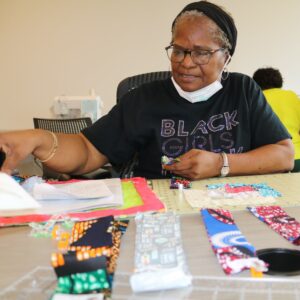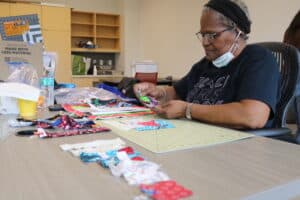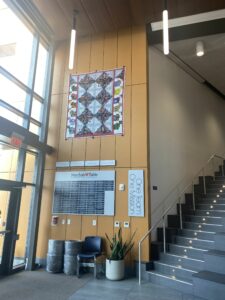Tuesday, February 28, 2023 at 1:14 PM
Passing Down the Art and Tradition of Quilting from our Ancestors

Tuesday, February 28, 2023 at 1:14 PM

Quilting is an art that has no boundaries. You can express whatever you would like. If you are interested in your family history, you could sew a quilt that tells that story. If you are excited about the community you live in, you can express that too. There are endless possibilities in putting a quilt together.
 Quilts are also powerful tools of communication.
Quilts are also powerful tools of communication.
Two years ago, I attended a presentation on quilt codes used in the Underground Railroad by fellow community member and retired educator Dr. Blanche Brownley. I learned that day that enslaved people used quilts as a communication tool for freedom. The different patterns and symbols sewn into the fabric were instructions to guide enslaved people to freedom safely. The breakdown of these codes was really meaningful to me in understanding my ancestral history.
After the presentation, Dr. Brownley and I met with the Martha’s Table team regularly to plan what a quilting group would look like at Martha’s Table. We wanted to create a space of intention that would bring people together from all walks of life to learn about the art of quilting while also using a historical lens to understand our African American roots. We named this group the Quilt Corner. We began working on a community quilt recently presented to Martha’s Table in November 2022 at Martha’s Table’s Annual Harvest Dinner. We named this quilt the Log Cabin Community Quilt.

This community quilt is now hanging up in Martha’s Table’s lobby at their Southeast location and is the first one completed by Quilt Corner. It comprises the Log Cabin pattern using over 20 12-inch squares. We chose the Log Cabin pattern characterized by the dark and light motif on each square. We wanted to honor our African American history by uplifting the message of safety and support that the Log Cabin pattern represents. As we came together in fellowship to sew this beautiful quilt, we remembered Harriet Tubman, William Still, and Frederick Douglas, who equally promoted the Underground Railroad and dedicated their lives to ensuring secure paths to freedom for enslaved people. We wanted to carry on their legacy by showing light and positivity for our community today in Anacostia. We want our community to know we are looking out for each other like our ancestors looked out for us.
I’m excited about the continuation and growth of this phenomenal group. Anyone is welcome to participate in the Quilt Corner. We want people to come with excitement and curiosity to learn. It’s no easy thing to quilt. The number one thing I always tell people is patience because you’ll make mistakes, especially if you’ve never put a needle and thread together, used a sewing machine, or cut out a pattern. However, with the assistance of the supportive community we have established here, you can learn how to do these things at your own pace. That’s how I learned and found my passion for quilting, and I want to empower others to partake in this unique and historical art form.
To register for the Quilt Corner, click here.
About the Author:
Ms. Charlene Hursey is a retired educator who has lived in Ward 8 for over 20 years. She is an active community member participating in the Seasoned Seniors at Fort Stanton Recreation Center and several Martha’s Table groups, including the Community Advisory Council, Changemakers Book Club, and Quilter’s Corner. She’s a quilting enthusiast and encourages everyone of age and skill levels to come and check it out!
 News
NewsOctober 18, 2024 at 5:01 PM
2024 Honorees Ms. Cathy Hughes and Mr. Joe Houston Jr. Photo: Asuquo Eton
October 9, 2024 at 12:44 PM
On September 28, Martha’s Table celebrated community spirit at our first-ever Joyful Pumpkin Patch, drawing over 1,000 attendees for a day of joy and connection. From pumpkin picking to live cooking demos by top chefs, the event highlighted the strength of our Anacostia community. Want to get involved? Discover how you can volunteer at our upcoming Joyful Food Markets and help spread the joy!
September 30, 2024 at 8:59 AM
Are you passionate about cars and looking to start a rewarding career in the automotive industry? We have exciting news! In collaboration with Vehicles for Change VR, Martha’s Table is launching a cutting-edge Virtual Reality (VR) Automotive Technician Training Program designed to equip you with the skills needed to succeed in the automotive field.
 Connected
Connected
0 New comments